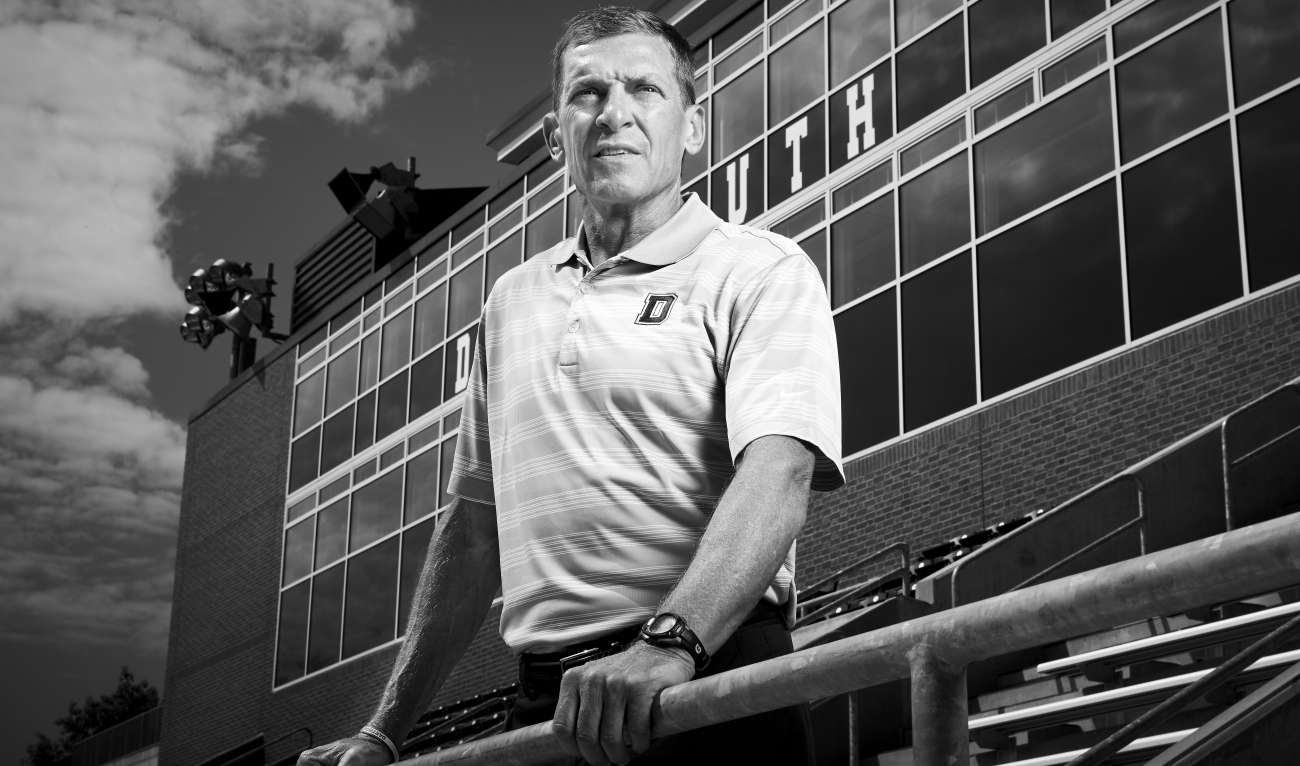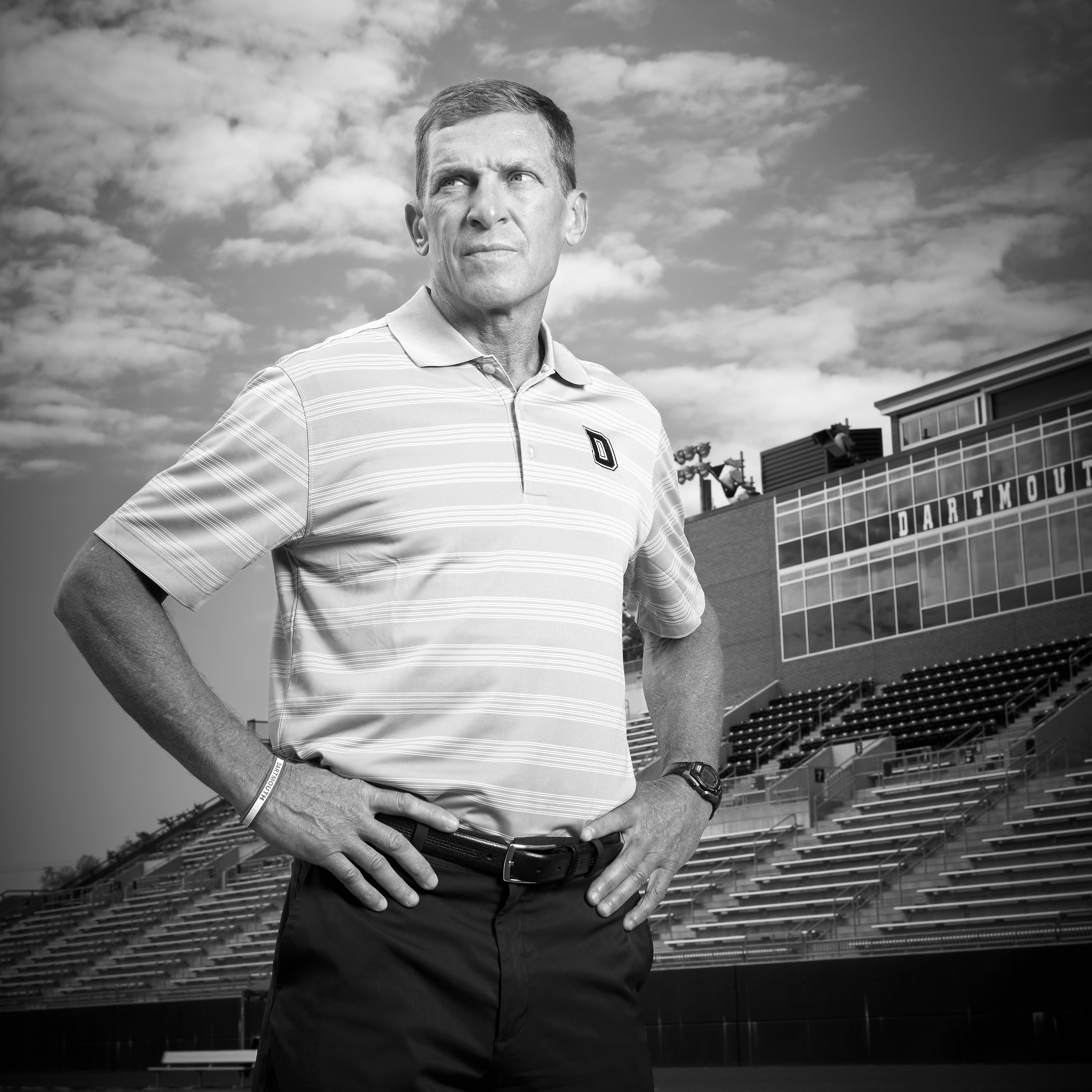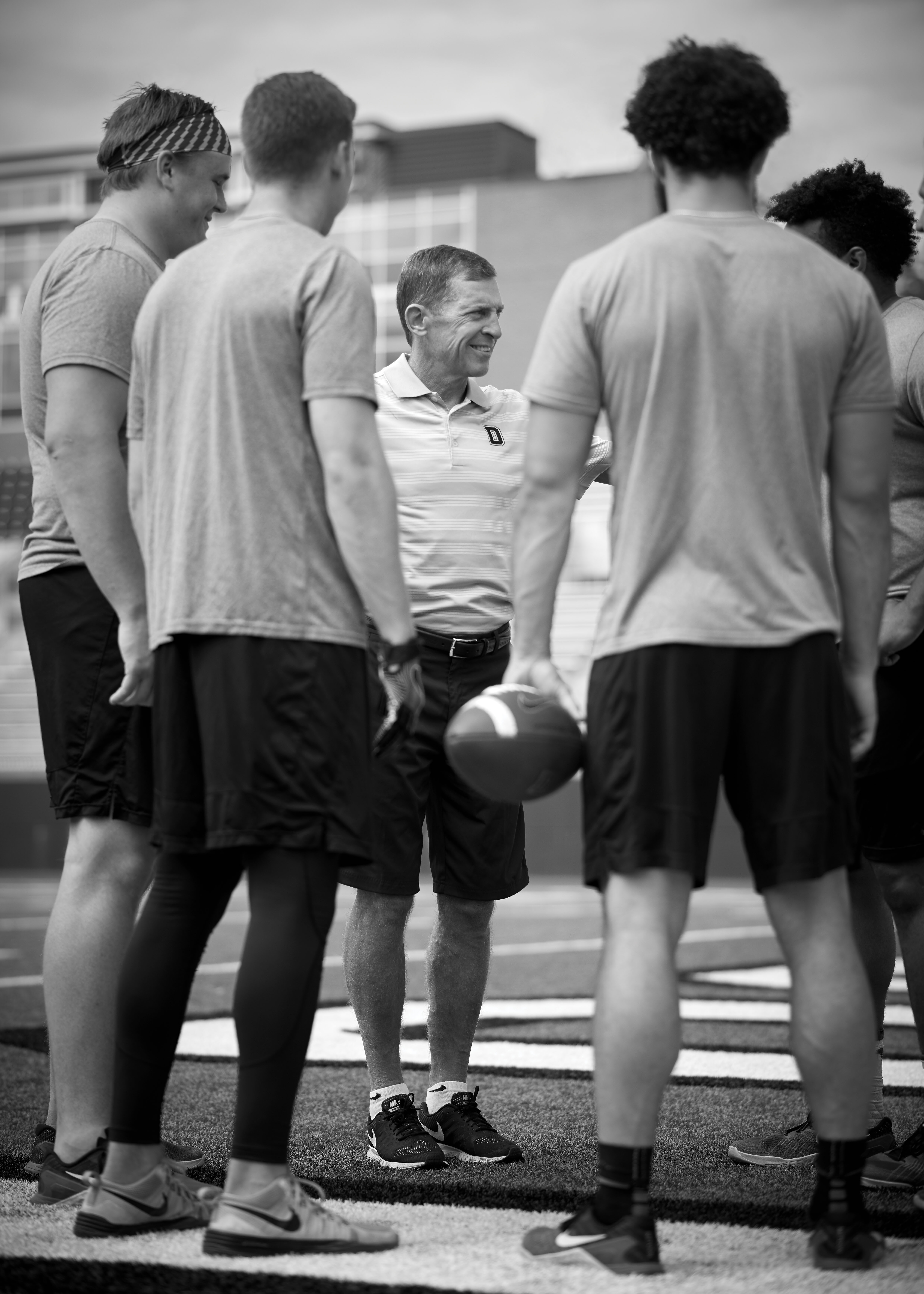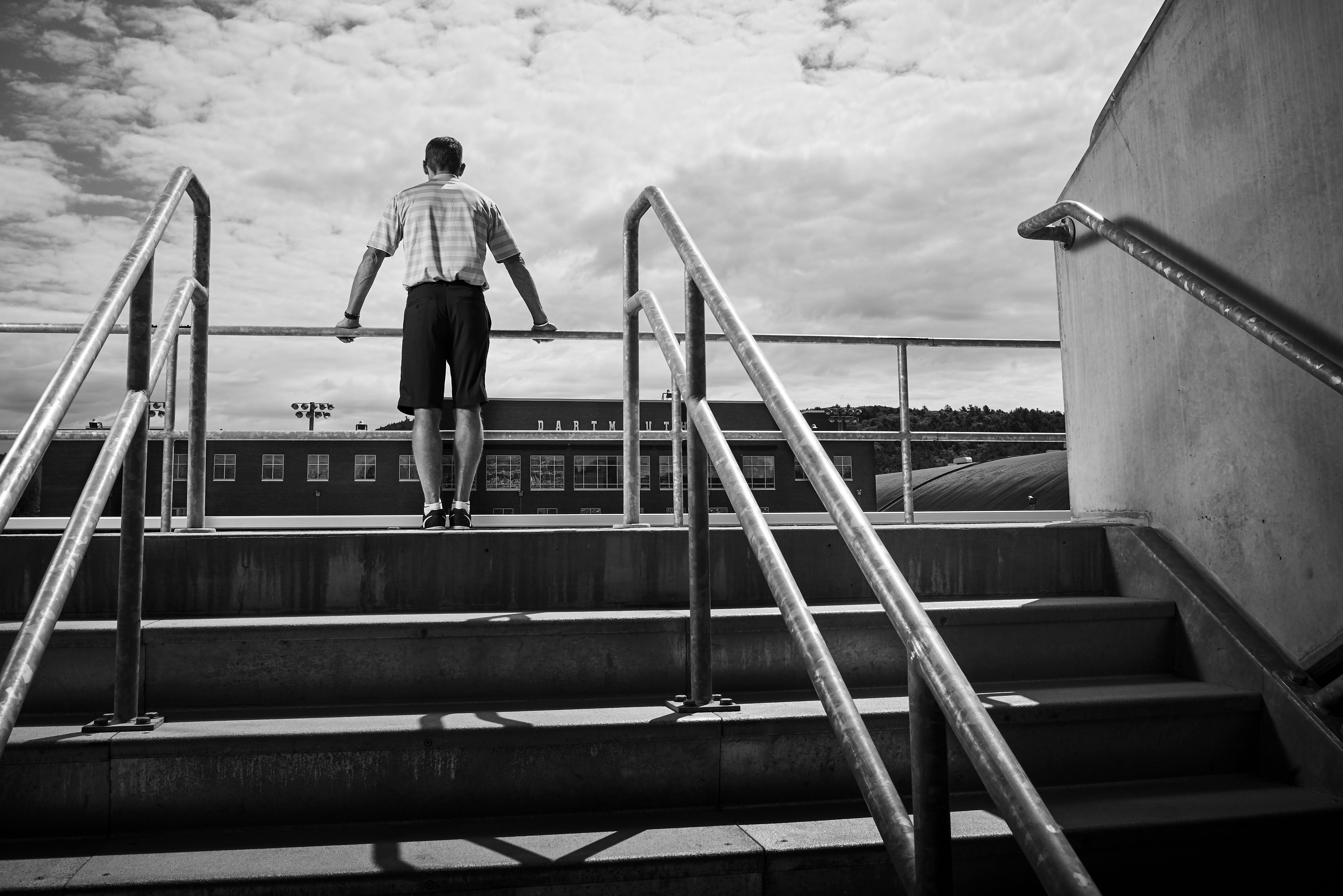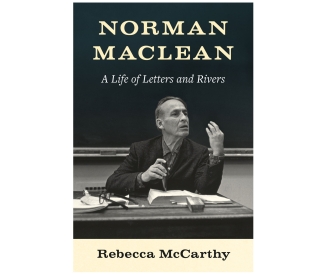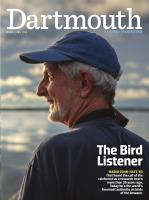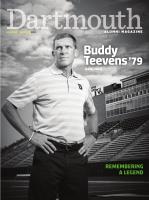How Buddy Teevens ’79 Transformed Football Forever
The Pittsburgh Amtrak station is a strange place to start a profile of Buddy Teevens.
It’s more than 600 miles from Hanover, where Teevens makes his living as Dartmouth’s head football coach. He’s never even been to the station.
Yet this is where his quest to save football began. Because this is where Mike Webster sometimes slept during the final years of his life.
An NFL Hall of Fame center who won four Super Bowls with the Pittsburgh Steelers, Webster—known as “Iron Mike”—went more than 10 seasons without missing a game. His troubles began soon after he retired in 1990. His thoughts tangled. His speech rambled. His business dealings and personal finances collapsed. His behavior became erratic. One day he walked into his kitchen and, in front of his family, peed in the oven.
After a divorce and bankruptcy, he lived in his car, the bus station—and yes, the Pittsburgh Amtrak station, where bewildered fans recognized a football legend living off of potato chips and dry cereal. He shook constantly. Some nights, desperate to make his tremors stop long enough to steal a few minutes sleep, he’d zap himself with a Taser.
Following his death in 2002, Webster’s body—and brain—ended up on the examining table of Allegheny, Pennsylvania, forensic pathologist Bennet Omalu (played by Will Smith in the 2015 movie Concussion). Webster, who was never diagnosed with a concussion as a player, became the first former NFL player to be diagnosed with chronic traumatic encephalopathy (CTE), the condition that poses an existential threat to America’s favorite game.
“The Mike Webster story,” Teevens says, “really got me thinking.”
Granted, Teevens has been in worse places than the Pittsburgh Amtrak station.
Like 2-8.
That was his win-loss record in 2005, the first season of his second stint at Dartmouth, where he’d previously coached from 1987 to 1991. It was also his record in 2006. And—after going 3-7 in 2007 and winless in 2008—2-8 was his record again in 2009.
This was not entirely his fault. The Big Green won a record 17 titles during the first 41 years of Ivy League play, including one with Teevens at quarterback in 1978, and two by Teevens the coach in 1990 and 1991. But in the late 1990s, the team fell into a deep slumber.
“A lot of coaches are aware of the research and want to make changes. Buddy is at the forefront of doing something about it.”
The clear culprit was recruiting. Dartmouth’s academic profile had improved to the point where the College was forced to compete with the likes of Harvard, Yale, and Princeton for top players, and it was losing those battles—either because it wasn’t matching what other schools offered in financial aid or because, as Dartmouth coaches quietly griped, relations with the admissions department hovered just north of abysmal.
That last point was underscored in 2004, shortly after the firing of Dartmouth coach John Lyons, when what is now remembered as “the Furstenberg Letter” was leaked to the Valley News. In it, dean of admissions and financial aid Karl M. Furstenberg praised the president of Swarthmore for eliminating its football program, calling the sport “antithetical to the academic mission of colleges such as ours.”
“That letter was a disaster in at least two ways,” says Harry Sheehy, who had to deal with fallout from the letter six years later in 2010, when he became Dartmouth’s athletics director. “One, it didn’t become public for four years after it was written. So, for four years [Furstenberg] was selecting football players for us, with us not knowing what had been written. And when it came out, it was a disaster. Who’s going to come here when that’s the attitude?”
Then there were the antiquated campus facilities. Teevens recalls visiting after the 2004 season. Dartmouth was searching for a new coach, and Stanford had let him go after three seasons (and a 10-23 record). “It was like I walked back in time,” says Teevens. “Nothing had changed. The wear marks on the carpet were the same as when I had left.”
Teevens took the job only when then-president Jim Wright promised significant improvements to football specifically and to athletics generally—a commitment his successor, Jim Kim, honored. Floren Varsity House, football’s new home, opened in 2007. Stadium and weight room upgrades soon followed.
No one expected a quick fix. Still, as the years went by and the 2-8 seasons piled up, Teevens was in trouble. “I never doubted that what we were doing would work,” says Teevens. “It was just whether I would be around to see it through.” Coming out of that 0-10 season in 2008, Dartmouth did what institutions often do when they need to fire someone they don’t really want to fire.
The College hired a consultant.
His name was Rick Taylor. An assistant coach at Dartmouth in the 1970s, he’d had a long career as a football coach and athletic director, finally retiring from Northwestern.
Taylor’s report noted improvements to facilities and in admissions. But Dartmouth’s nonconference schedule was too difficult. The team needed more money for recruiting. And Teevens, who also served as quarterback coach and offensive coordinator, needed to relinquish those duties and concentrate on being head coach.
In other words, the College didn’t need to fire Buddy. It needed to help him. The team lured two longtime Ivy League assistants to Hanover by offering them better salaries: Don Dobes came from Princeton to be defensive coordinator, and Keith Clark came from Yale to coach the offensive line. Teevens, who admits he can be “a micromanager,” says being forced to step back from a more hands-on role was “frustrating at times, professionally.” But it also freed him to focus on his strengths: recruiting and fundraising. “I was very, very fortunate to be allowed to continue,” he says. “If it wasn’t my alma mater, and if people didn’t look deeply in terms of what we were doing, I would have been unemployed.”
Teevens’ position remained tenuous entering the spring of 2010. Having digits at the end of his name would not help him much longer if he didn’t start winning. This was probably not the moment to embark on a radical experiment to dramatically change the entire sport of football.
Yet it was around this time that CTE was bursting into the national conversation. Football entered the bizarre paradox where it finds itself today: It’s the most popular sport in America, by a wide margin, and it’s also in deep crisis. As injuries mount, nervous parents are steering their kids away, causing participation levels to plummet.
The Mike Webster story hit a nerve with Teevens. So did conversations with fellow coaches—including his former boss at Florida, Steve Spurrier, and his mentor at Stanford, Bill Walsh. His players were going on to careers in medicine, finance, and engineering, where they would need their brains. Researchers were finding that repeated subconcussive hits, such as those that doomed Webster, were leading to later-life CTE.
And the majority of those hits (60 percent, according to studies) didn’t take place during games. They happened in practice, during barbaric-but-common drills such as “Oklahoma,” in which a defensive player lines up 10 yards from an offensive one, then attempts to knock the snot out of him—a time-honored method of teaching tackling.
But what if they could find a new, less-violent way? One that took player-on-player contact out of the equation?
“It was a cumulative thing. And the sum of it all was, why are we doing this?” says Teevens. “And so I just decided we’re not going to tackle in practice anymore.”
The reaction was something less than universal recognition of his genius. Teevens says fellow head coaches called him an idiot and told him he was going to get fired. Even his own assistant coaches asked him what the punchline was.
Then they got to work. No college program had ever eliminated tackling from practices. Dartmouth’s coaches started breaking down film, studying tackling like never before. They learned that the historical archetype of a so-called “perfect form” tackle—which begins when the defensive player drives the crown of his helmet into the opposing player’s chest—almost never happens in a game. Most tackles were, in fact, distinctly imperfect.
Back out on the field, they used dummies and crash pads to replicate what they’d seen players do on film. No human athletes. “It was a learning process,” says Teevens. “There was no template to steal from. It was just coming up with stuff as we went along.”
Then a funny thing happened to the team that no longer tackled in practice. Players started tackling much better in games. In 2010, missed tackles dropped by half, according to Teevens. The players were also healthier, fresher, and missed far fewer games due to injuries. Dartmouth finished 6-4 that year, its first winning season since 1997.
The coaches kept tinkering. Before long, Teevens used what he now called “the Dartmouth Way” of teaching tackling to win something else: recruiting battles. Take, for example, linebacker Jack Traynor ’19. The leading tackler in Illinois high school history, he was wooed by Harvard, Penn, Princeton, and Yale. Late in the process, he got a visit from Teevens, who sat down with Jack and his parents, Carl and Darcy.
“Jack has been a fan of contact since he was in the second grade. When Jack heard about the no-tackle thing, there was disbelief,” says Carl. “For Darcy? Holy smokes. She was sold. When Coach Teevens left our home, Darcy just looked at me and said, ‘Jack needs to go to school there.’ ”
Several more winning seasons followed, including an 8-2 mark in 2014. Then came 2015 and the breakthrough. Dartmouth finished 9-1 to share the Ivy League title, thanks in part to a stifling defense that allowed only 10.1 points per game—the best in the nation by three points.
“People were laughing at us for a long time,” recalls Dobes, the architect of that defense. “But if you look at that 2015 team, we had almost no injuries. Ten guys who started on defense against Georgetown in the first game of the season started against Princeton in the last game of the season. They weren’t laughing at us anymore.”
Teevens next won perhaps an equally satisfying honor. After the season, the Ivy League voted unanimously to eliminate tackling from practices during the season. “That conversation took five minutes,” says Teevens. “We had just won a championship. They all played us. They all knew we tackled well.”
It would make for a nice story to say the nation’s other conferences immediately recognized the Ancient Eight’s wisdom and followed suit. In fact, none have. Even the rest of the Ivy League still tackles during preseason and spring practices. Dartmouth remains alone in the no-tackle wilderness—both in the league and the nation.
“No one is as far out there as Buddy is right now,” says Robert Cantu, cofounder of the CTE Center at the Boston University School of Medicine and arguably the nation’s leading authority on the condition. “A lot of coaches, like Nick Saban at Alabama and David Shaw at Stanford, are aware of the research and want to make changes. Buddy is at the forefront of doing something about it.”
One of the efforts Teevens remains involved with is the Mobile Virtual Player (MVP), a remote-controlled football robot. It began as a hairbrained idea of Teevens. One day in the spring of 2011 he asked classmate and Thayer School research engineer John Currier ’79, Th’81, if he could make a tackling dummy move. Now Teevens’ small startup venture, MVP LLC, has a staff of six, including ex-football player Ryan McManus ’15 and ex-rugby player Quinn Connell ’13, Th’14, who helped design the prototype as an undergraduate at Thayer.
While Currier admits MVP is “still something of a novelty,” it is now being used by half of the teams in the NFL and 33 colleges. “A lot of coaches are realizing they can’t just spit tobacco and run the Oklahoma drill anymore,” he says. “There is a strong and universal trend toward less contact in football, and MVP is part of that paradigm.”
MVP and Teevens have been featured on The Late Show with Stephen Colbert, in The Boston Globe and The Washington Post, and on an ad that ran during last year’s Super Bowl—just part of the glut of attention the coach has garnered as college football’s leading no-tackle evangelist. He’s become a go-to speaker at coaches’ conferences and recently got a visit from NFL Commissioner Roger Goodell, who dropped in on spring practice to witness the Dartmouth Way. He calls Teevens “an innovative leader whose impact is reaching all levels of our sport.”
When the U.S. House of Representatives subcommittee on oversight and investigations convened a hearing on concussions in youth sports two years ago, Teevens testified. “If we don’t change the way we coach the game, we won’t have a game to coach,” he told a rapt group of representatives.
“I’m just of the mindset we all have got to do this eventually,” says Teevens. “So when do you embrace it? You can be the last guy on the bus, or you can be the guy who’s leading the charge.”
No one would care how Dartmouth practiced if the team were still 2-8. Instead, a winning buzz now surrounds Dartmouth football. The Big Green went 8-2 last year, losing those two games by a combined eight points. A stud quarterback, Jake Allen ’22, has transferred from Florida and should help keep Dartmouth in the conversation this fall.
Buoyed by continued success and Teevens’ relentless enthusiasm—he is surely one of the few Division I head football coaches to pepper his emails with smiley face emoji—Friends of Dartmouth Football now brings in $1.5 million a year, more than four times what it did a decade ago. This has allowed coaches greater flexibility and range in recruiting, even if Teevens still sometimes acts like he hasn’t gotten the memo. He packs a jar of peanut butter and a loaf of wheat bread for road trips so he doesn’t have to eat at restaurants.
Teevens no longer calls plays during games, but he is no out-of-touch CEO. Bruce Wood, who runs a subscription newsletter dedicated to Dartmouth football called Big Green Alert, recently asked Teevens for a “brief overview” of spring practice. Teevens proceeded to rattle off a position-by-position breakdown off the top of his head, without notes.
More important, Teevens drills into his players that they are expected to attend every class, sit up front, and introduce themselves to their professors. Once a week the football team puts up an “A-board” list of every player who has earned an A on an assignment. “Before the Princeton game last year, we had 92 guys’ names on the board,” Teevens says. “We want kids to be as passionate in the classroom as they are on the field.”
Dartmouth football’s graduation rate for the class of 2014, the most recent year for which NCAA results have been tabulated, was 100 percent. Its five-year average is 97.6 percent.
At 61, Teevens remains as trim as he was during his playing days. He either runs, bicycles, swims, or lifts weights every day. McManus, the former Big Green wide receiver, says Teevens was notorious for joining especially grueling early-morning workouts, known as “Breakfast Club,” and lapping his own gasping players—a feat that only grows more impressive now that Teevens and his wife, Kirsten, have four grandchildren.
His longtime friend, Dave Shula ’81, the former Cincinnati Bengals head coach and son of the winningest coach in NFL history, says Teevens still “burns as hotly as my dad or anybody I’ve ever been around.” Shula is back in Hanover, having stepped away from running a successful chain of steakhouses to become Dartmouth’s wide receivers coach. One of his favorite photos is from 2007, when Teevens bicycled across the country and Shula joined him to climb the mountains to Flagstaff, Arizona. In the picture, Teevens is little more than a yellow dot, far off in the distance.
“That, to me, is Buddy,” Shula says. “He’s always way out ahead.”
Brad Parks is an author of eight novels, most recently Closer Than You Know.

